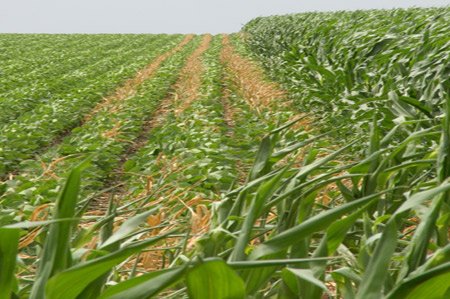 (Bloomberg) – After soybean fields from North Dakota to Ohio got more than twice the normal rainfall in August, Iowa farmer Jason Marienau expects the wet weather that plumped up his beans to boost yields to a record.
(Bloomberg) – After soybean fields from North Dakota to Ohio got more than twice the normal rainfall in August, Iowa farmer Jason Marienau expects the wet weather that plumped up his beans to boost yields to a record.
The showers helped fill his pods with fatter seeds, and the crop looks so good he estimates this year 2,300 beans will weigh one pound (0.45 kilogram), compared with 3,000 in a normal year, on some of his fields near Le Mars, in northwest Iowa. Higher prices before sowing started prompted U.S farmers to plant 11 percent more than in 2013, and the bigger yields are raising the outlook for a harvest that the government already forecast at an all-time high.
“We got seeds planted early, and we did not have any extremes in rain or temperatures,” Marienau, 37, said by telephone Sept. 5. “You never seem to have record yields when there is record U.S. planted acreage. This year is going to be different, because we have more pods per plant and the beans are going to be big.”
Production in the U.S., the world’s largest grower and exporter, will be 2 percent bigger than the government estimated last month and inventories before the 2015 harvest will more than triple, a Bloomberg survey showed. Rising supplies will send prices that reached a four-year low last week down a further 10 percent by October, according to AgResource Co. The glut will cut feed costs for hog and poultry producers.
“It could be an out-of-this-world soybean crop,” Roger Fray, the executive vice president of grain at West Central Cooperative based in Ralston, Iowa, said in a telephone interview Sept. 5. “If you are downstream from the crops, it’s your time to shine. There is no one that uses corn or soybeans that is not making very good money.”
Biggest Crops
U.S. output will jump 18 percent this year to an all-time high of 3.894 billion bushels on record yields of 46.3 bushels an acre, the average of 32 forecasts in a Bloomberg survey showed. Supplies are climbing as domestic farmers are also poised to collect the biggest corn crop ever and global wheat reserves are set to reach a three-year high, the Department of Agriculture estimates. The agency will update its crop outlook Sept. 11 at noon in Washington.
Soybean futures for November delivery are down 11 percent this year to $10.0475 on the Chicago Board of Trade. The oilseed touched $10.0125 on Sept. 4, the lowest for a most-active contract since 2010. The Bloomberg Commodity Index of 22 commodities fell 1.5 percent in 2014, and the MSCI All-Country World Index of equities advanced 5.2 percent.
Cheaper Grain
Cheaper grain is bolstering profit for buyers including Tyson Foods Inc. (TSN) and Archer-Daniels-Midland Co., encouraging some cattle producers in the Great Plains to expand herds, while eroding income for grain farmers. Soybeans will reach $9 as harvesting peaks next month, Bill Tierney, the chief economist at AgResource Co. in Chicago, said Sept. 5.
Demand for U.S. soybeans continues to rise, making up for a “return to more normal supplies,” according to Christoper Narayanan, the head of agricultural research at Societe Generale. He forecast on Aug. 25 that soybean production this year would rise to 3.783 billion bushels, below the USDA’s estimate of 3.816 billion made on Aug. 12.
China, the world’s largest consumer, will boost imports 5.8 percent to 73 million metric tons in the year that begins Oct. 1, the 11th straight record, the USDA estimates. U.S. export sales for delivery before Aug. 31 rose 5.5 percent to 21.67 million tons compared with a year earlier, with Chinese purchases accounting for more than 57 percent, the agency said last week.
China Demand
“China can’t grow enough soybeans to expand hog production, so they will have to import more,” Narayanan said in a telephone interview Sept. 5. “We see a slightly tighter picture” for supplies than most traders, he said.
August ranks as one of the top 10 wettest ever for the month in 120 years of records, according to preliminary estimates from T-Storm Weather LLC. Since 1960, seven of the 10 highest U.S. soybean crops occurred when August rainfall was higher than normal, said Mike Tannura, the president of T-Storm Weather in Chicago.
For Iowa’s Marienau, the showers mean he expects to produce 65 bushels an acre, 25 percent more than the average over the past 10 years. On the land he farms with two partners in South Dakota, yields will be 13 percent higher.
Hedge funds and other money managers have the most-negative outlook on soybeans since October 2006, with a net-short holding of 25,574 U.S. futures and options contracts as of Sept. 2, government data show.
Brazil Production
As U.S. supplies rise, output will be a record for a third straight year in South America, including an all-time high of 91 million tons in Brazil, the second-biggest exporter, USDA data show. Global stockpiles on Aug. 31, 2015, probably will rise to a record 86.08 million tons from 67.09 million expected this year, a Bloomberg survey showed. That’s equal to more than 30 percent of estimated demand, up from about 21 percent in 2012, when futures reached a record $17.89, signaling that prices will fall to $9.50 during the harvest, according to Rabobank.
“The world is going to be swimming in soybeans because supply has finally caught up with demand,” Steve Nicholson, a vice president for food and agricultural research at Rabo AgriFinance in St. Louis, said in a telephone interview Sept. 7. “China’s imports will continue to increase, but are not anticipated to keep up with the growth in production.”




